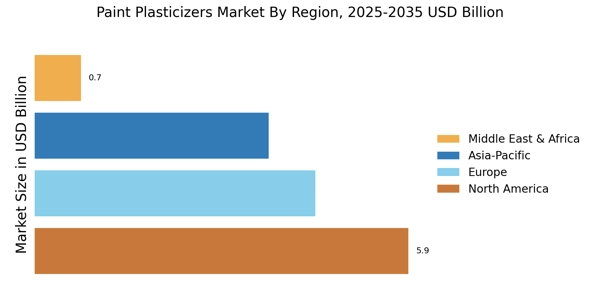Regulatory Compliance
Stringent regulations regarding the use of harmful chemicals in paints and coatings are shaping the Paint Plasticizers Market. Governments worldwide are implementing policies to limit the use of phthalates and other hazardous substances, prompting manufacturers to seek compliant alternatives. This regulatory landscape is likely to drive innovation in the development of safer plasticizers, which could lead to a market shift towards non-toxic options. The need for compliance not only affects product formulation but also influences market entry strategies for new players. As regulations evolve, the Paint Plasticizers Market may witness a transformation in product offerings, with a focus on health and safety.
Sustainability Initiatives
The increasing emphasis on sustainability within the Paint Plasticizers Market is driving demand for eco-friendly plasticizers. Manufacturers are increasingly adopting bio-based and non-toxic alternatives to traditional plasticizers, aligning with regulatory standards and consumer preferences. This shift is evident as the market for bio-based plasticizers is projected to grow at a compound annual growth rate of approximately 5.5% over the next few years. Companies are investing in research and development to create sustainable products that minimize environmental impact, which is likely to enhance their competitive edge. As consumers become more environmentally conscious, the demand for sustainable solutions in the Paint Plasticizers Market is expected to rise, influencing purchasing decisions and market dynamics.
Technological Advancements
Technological advancements in the formulation and production of plasticizers are playing a pivotal role in the Paint Plasticizers Market. Innovations in chemical engineering and material science are enabling the development of new plasticizers that offer improved performance characteristics, such as enhanced compatibility and lower volatility. These advancements are likely to lead to the introduction of high-performance plasticizers that meet the evolving needs of the market. Furthermore, automation and digitalization in manufacturing processes are expected to increase efficiency and reduce costs, thereby benefiting producers and consumers alike. As technology continues to evolve, the Paint Plasticizers Market may experience a wave of new product introductions and enhanced production capabilities.
Rising Construction Activities
The resurgence of construction activities across various sectors is significantly impacting the Paint Plasticizers Market. As urbanization continues to accelerate, the demand for paints and coatings in residential, commercial, and industrial applications is on the rise. This trend is supported by data indicating that the construction sector is expected to grow at a rate of 4.2% annually. Consequently, the need for high-performance plasticizers that enhance the durability and flexibility of paints is becoming increasingly critical. Manufacturers are responding to this demand by developing innovative plasticizers that cater to the specific needs of the construction industry, thereby driving growth in the Paint Plasticizers Market.
Consumer Preferences for Performance
The growing consumer preference for high-performance paints is influencing the Paint Plasticizers Market. As end-users seek products that offer superior durability, flexibility, and resistance to environmental factors, manufacturers are compelled to innovate. This trend is reflected in the increasing demand for specialty plasticizers that enhance the performance of paints and coatings. Market data suggests that the segment for high-performance plasticizers is expected to witness a growth rate of around 6% annually. This shift in consumer expectations is prompting manufacturers to invest in research and development to create advanced formulations that meet these demands, thereby driving growth in the Paint Plasticizers Market.


















Leave a Comment